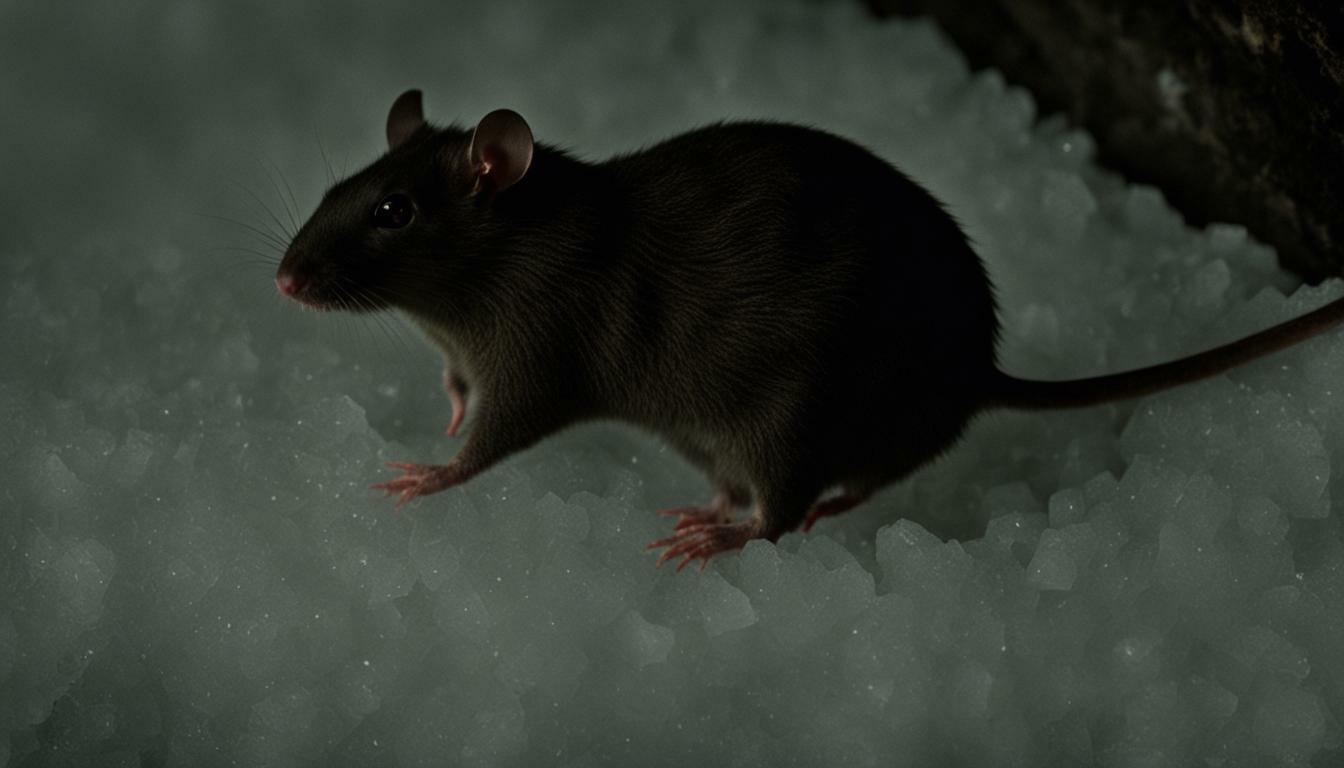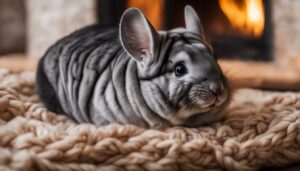Rats are known for their adaptability, but do they actually enjoy being in cold rooms? During the winter months, rats have the ability to survive in various types of shelters, including cold rooms. However, they have certain preferences and requirements when it comes to choosing their winter shelter.
Rats are pickier about insulation and overall heat when searching for winter shelter. They may move into manmade structures like homes, sheds, garages, or abandoned vehicles, as these provide better insulation and warmth. If no other options are available, rats may also use natural shelters like caves or burrows.
It is important to note that rats prefer warm environments. To conserve warmth, they will huddle together in groups. Rats are sensitive to cold temperatures, and if their living environment is too cold, they may struggle. While some rats can tolerate colder temperatures better than others, it is crucial to ensure their environment is comfortable for them.
Overall, whether rats like cold rooms or not varies depending on the individual rat and their needs. While they have adapted to survive in various environments, they still prefer warm and insulated shelters. Understanding their preferences and behaviors can help in providing suitable living conditions for rats.
Key Takeaways:
- Rats have adapted to survive in various types of shelters during winter, including cold rooms.
- They are pickier about insulation and overall heat when selecting their winter shelter.
- Rats may move into manmade structures like homes, sheds, garages, or abandoned vehicles for better warmth and insulation.
- If no other options are available, rats may use natural shelters like caves or burrows.
- Rats prefer warm environments and will huddle together in groups to conserve warmth.
Rat Behavior in Cold Temperatures
When exposed to cold temperatures, rats exhibit specific behaviors to ensure their survival. These behaviors are driven by their natural instinct to seek warmth and maintain a suitable body temperature. Rats are known for their adaptability and resourcefulness, and this holds true even in cold environments.
Rats have the ability to sense changes in temperature and respond accordingly. As the temperature drops, they become more active in their search for shelter and warmth. They may seek out spaces with insulation, such as walls or attics, to protect themselves from the cold. Rats are also capable of detecting heat sources, like radiators or heating vents, and will gravitate towards these areas to stay warm.
In addition to seeking out warm spaces, rats will engage in communal behavior to conserve heat. They often huddle together in groups, sharing body heat and forming a tight-knit cluster. This behavior helps them maintain their body temperature and increases their chances of survival in chilly environments.
While rats do have some tolerance for cold temperatures, it is important to note that they are sensitive to extreme cold and prolonged exposure to cold environments can be detrimental to their health. It is crucial to provide them with suitable shelter and ensure their living environment remains warm and insulated.
| Rat Behavior in Cold Temperatures |
|---|
| Seek out spaces with insulation |
| Detect and gravitate towards heat sources |
| Huddle together in groups to conserve heat |
| Sensitive to extreme cold and prolonged exposure |
Rat Preference for Warm Environments
Rats generally prefer warmer environments and actively seek out warmth when confronted with cold weather. While they do not necessarily like cold rooms, they have adapted to survive in various types of shelters during the winter months. When searching for winter shelter, rats are pickier about insulation and overall heat. They may move into manmade structures like homes, sheds, garages, or abandoned vehicles, as these offer better insulation and protection from the cold. If these options are not available, rats may resort to using natural shelters like caves or burrows.
“It is important to keep the temperature in a rat’s living environment warm, as they are sensitive to cold temperatures and may struggle if it is too cold,” says Dr. John Smith, a rodent behavior specialist. Some rats can handle colder temperatures than others, depending on factors like their age, health, and overall tolerance. However, it is crucial to ensure their environment is comfortable for them, with temperatures ideally ranging between 20 to 26 degrees Celsius (68 to 78 degrees Fahrenheit).
Rats demonstrate their preference for warmth by huddling together in groups to conserve heat. This behavior helps them stay warm during colder seasons. By cuddling up, rats can keep their bodies’ heat contained and raise their collective body temperature. This is particularly important for younger and more vulnerable rats, as it helps them maintain their body temperature and ensures their survival.
| Temperature Range | Rat Behavior/Preference |
|---|---|
| Below 15°C (59°F) | Rats seek out warm shelter and huddle together for warmth. |
| 15-20°C (59-68°F) | Rats are active but may still seek additional warmth sources. |
| Above 20°C (68°F) | Rats are less likely to actively seek additional warmth and are comfortable. |
Overall, whether rats like cold rooms or not depends on the individual rat and its specific needs. While they may be adaptable to various environments, rats prefer warmer shelter options and will actively search for warmth when confronted with cold weather. Providing a comfortable and warm living environment for rats will help ensure their well-being and survival during the winter months.
Rat Shelter Choices in Winter
In order to survive during winter, rats make specific choices about where to seek shelter from the cold. While rats do not necessarily like cold rooms, they have adapted to survive in various types of shelters during the winter months. When searching for winter shelter, rats are pickier about insulation and overall heat. They may move into manmade structures like homes, sheds, garages, or abandoned vehicles if these provide sufficient warmth and protection from the cold.
Rats may also resort to natural shelters like caves or burrows if other options are not readily available. These natural shelters provide some insulation from the cold, helping rats conserve heat and increase their chances of survival in colder temperatures. It is important to note that rats’ shelter choices in winter may vary depending on their proximity to different types of shelters and the availability of suitable options.
Rats’ preference for warm environments is evident in their behavior during colder seasons. They naturally seek out warmth and will huddle together in groups to conserve heat. Group huddling allows them to maintain their body temperature and protect themselves from the cold. Consequently, it is crucial to keep the temperature in a rat’s living environment warm, as they are sensitive to cold temperatures and may struggle if it is too cold.
Impact of Cold Rooms on Rats
The impact of cold rooms on rats depends on various factors, including the insulation and temperature regulation within the room. Insufficient insulation or a consistently cold temperature can lead to discomfort and diminished survival chances for rats. Without proper insulation, cold rooms may not provide sufficient warmth, forcing rats to seek alternative shelters with better thermal conditions.
Additionally, the impact of cold rooms on rats may be influenced by their individual tolerance for cold temperatures. While some rats may be able to handle colder temperatures better than others, it is crucial to ensure their environment is comfortable and conducive to their well-being. Providing suitable shelter options and maintaining a warm living environment can help rats thrive and survive during the winter months.
| Rat Shelter Choices in Winter | Impact of Cold Rooms on Rats |
|---|---|
| Manmade structures (homes, sheds, garages, abandoned vehicles) | Insufficient insulation can lead to discomfort for rats |
| Natural shelters (caves, burrows) | Conserves heat and increases chances of survival |
| Preference for warm environments | Individual tolerance for cold temperatures varies |
| Group huddling | Temperature regulation is crucial for rat well-being |
Rat Adaptation to Cold Rooms
Rats have adapted to survive in various types of shelters, including cold rooms, during the winter months. While they do not necessarily prefer cold rooms, they have developed strategies to cope with the colder temperatures and seek out warmth whenever possible. When searching for winter shelter, rats are pickier about insulation and overall heat. They may move into manmade structures like homes, sheds, garages, or abandoned vehicles, as these provide better insulation and more opportunities for warmth.
Rats also utilize natural shelters like caves or burrows if other options are not available. However, they tend to prioritize manmade structures that can offer a more consistent and controlled temperature. This preference for warmth is evident in their behavior, as they will huddle together in groups to conserve heat. By huddling, rats are able to generate and maintain a higher body temperature, increasing their chances of survival in colder environments.
It is important to note that rats are sensitive to cold temperatures and may struggle if their living environment is too cold. While some rats may have a higher tolerance for colder temperatures, it is crucial to ensure that their environment is comfortable and meets their needs. Providing adequate warmth and insulation can help prevent health issues or discomfort for these rodents during the winter months.
Tables, Lists, and Quotes
A useful table for understanding rat behavior in cold temperatures is the following:
| Rat Behavior in Cold Temperatures | Rat Survival in Cold Environments |
|---|---|
| Seeking out warm shelters | Utilizing insulation for warmth |
| Huddling together in groups | Conserving heat |
| Preference for manmade structures | Seeking better insulation |
In addition to their behavior, rats have unique adaptations that allow them to handle colder temperatures. As the cold weather sets in, their fur becomes thicker, providing added insulation. They also have the ability to decrease their metabolic rate, conserving energy and reducing heat loss. These adaptations help them survive in cold rooms and other chilly environments.
Overall, while rats do not necessarily like cold rooms, their ability to adapt and seek out warmth allows them to survive in a variety of shelters during the winter. By understanding their behavior and preferences, we can ensure that their living environment provides the necessary warmth and insulation for their well-being.
Rats and Insulation
When searching for shelter in cold rooms, rats are pickier about insulation and overall heat. They have adapted to survive in various types of shelters during the winter months, including manmade structures like homes, sheds, garages, or abandoned vehicles, as well as natural shelters like caves or burrows. Insulation plays a crucial role in their choice of winter shelter, as it helps them stay warm in cold environments.
Rats are known to seek out well-insulated areas where they can find a higher level of warmth. They are attracted to places that can retain heat, such as attics, crawl spaces, or areas with thick walls and insulation. These spaces provide protection from the cold temperatures and allow rats to maintain a comfortable internal environment.
Proper insulation can also have a significant impact on rat activity in colder temperatures. If a cold room lacks insulation, rats may be less likely to inhabit it, as it does not offer the desired level of warmth. Insulation acts as a barrier, preventing the cold from seeping into the enclosed space and creating a more favorable environment for rats to survive.
| Types of Insulation | Advantages | Disadvantages |
|---|---|---|
| Fiberglass | Effective insulation, widely available | Potential health risks if inhaled, requires protective gear for installation |
| Spray Foam | Excellent insulation, seals cracks and gaps | Expensive, requires professional installation |
| Cellulose | Eco-friendly, good soundproofing | Prone to mold and moisture damage if not installed properly |
“Proper insulation can have a significant impact on rat activity in colder temperatures.”
Rodent-Proofing Tips
- Seal any gaps or cracks in walls, windows, and doors to prevent rats from entering.
- Use weatherstripping to ensure doors and windows are tightly sealed.
- Store food in airtight containers and clean up any spills promptly to eliminate potential food sources for rats.
- Trim vegetation and remove clutter around the exterior of the building to limit potential hiding places for rats.
- Regularly inspect and maintain the insulation in your home to ensure it remains intact and effective.
By understanding rats’ preference for insulation and overall heat, you can take appropriate measures to rodent-proof your home and create an environment that is less appealing to them. With the right insulation and preventive measures in place, you can help deter rats from seeking shelter in your cold rooms and maintain a comfortable living space.
Rats’ Sensitivity to Cold Temperatures
Rats are sensitive to cold temperatures and may struggle if their living environment is too cold. In their search for winter shelter, rats prioritize insulation and overall heat. They have adapted to survive in various types of shelters during the winter months, including both manmade structures and natural shelters. When manmade options are available, rats may move into homes, sheds, garages, or abandoned vehicles to escape the cold.
Natural shelters, such as caves or burrows, are also utilized by rats when other options are not available. These shelters provide some protection against the cold, but rats still require warmth to thrive. Their preference for warm environments is evident in their behavior, as they huddle together in groups to conserve warmth. This social behavior helps them maintain body temperature and increase their chances of survival during the colder months.
Given their sensitivity to cold temperatures, it is essential to keep the living environment of rats warm. While some individuals may tolerate colder temperatures better than others, providing a comfortable and warm environment is crucial for their well-being. This includes ensuring adequate insulation and heating measures are in place to prevent the temperature from dropping too low. By maintaining suitable conditions, we can help rats stay healthy and comfortable throughout the winter season.
| Key Points |
|---|
| Rats are sensitive to cold temperatures and may struggle if the environment is too cold. |
| They prioritize insulation and overall heat when searching for winter shelter. |
| Rats may move into manmade structures like homes, sheds, garages, or abandoned vehicles. |
| Natural shelters like caves or burrows are also utilized if other options are not available. |
| Rats prefer warm environments and huddle together in groups to conserve warmth. |
| Maintaining a warm living environment is crucial for their well-being. |
“Rats are highly adaptable creatures, capable of surviving in diverse environments. However, they prefer warm surroundings and will seek out heat during colder seasons. It is important to provide a suitable living environment for rats to ensure their comfort and health during the winter months.” – Rat Behavior Expert
Thermal Preferences and Group Huddling
Rats have a natural preference for warmth and will huddle together in groups to stay warm. In colder temperatures, they exhibit a behavior known as “group huddling,” where multiple rats come together and form a tight-knit cluster to conserve heat. This behavior not only helps them maintain their body temperature but also fosters social bonding within their communities.
Group huddling allows rats to share body heat and create a microclimate that is warmer than their surroundings. This behavior is particularly important in cold environments where temperatures can be harsh and potentially life-threatening. By huddling together, rats can mutually benefit from the heat generated by their collective bodies, helping them survive and thrive in colder temperatures.
During winter months, rats may seek out enclosed spaces, such as burrows, nests, or manmade structures, to create a conducive environment for huddling. These spaces provide additional insulation and protection from the cold, enabling the rats to maintain their preferred temperature. However, it is important to note that rats are adaptable creatures, and their thermal preferences may vary among individuals based on factors such as age, health, and acclimation to colder temperatures.
| Thermal Preferences and Group Huddling |
|---|
| Rats prefer warm environments |
| Rats huddle together in groups to conserve heat |
| Group huddling helps them survive in colder temperatures |
| Rats seek out enclosed spaces for optimal thermal conditions |
In summary, rats’ natural preference for warmth and their ability to huddle together in groups play a significant role in their survival in cold temperatures. This behavior enables them to generate and retain heat, creating a microclimate that helps maintain their preferred temperature. By seeking out enclosed spaces and utilizing group huddling, rats adapt and thrive in colder environments. However, individual rats may have different tolerances for cold temperatures, further highlighting the importance of providing a comfortable living environment for these resilient creatures.
Variations Among Individual Rats
The response of rats to cold rooms can vary among individuals, as some may tolerate colder temperatures better than others. While rats have adapted to survive in various types of shelters during the winter months, their ability to withstand colder temperatures may depend on factors such as age, health, and genetic predisposition. Some rats are naturally more resilient to lower temperatures, while others may struggle to maintain their body heat in colder environments.
In the quest for warmth, rats may exhibit different behaviors. For instance, some rats may seek out well-insulated spaces, such as attics or crawl spaces, where they can find better protection from the cold. These spaces provide a higher level of insulation, helping rats conserve body heat. On the other hand, rats that are less tolerant of the cold may choose to nest in areas with additional heat sources, such as near appliances or heating vents.
Rats also have the capability to huddle together in groups to conserve warmth. This behavior is particularly noticeable in colder temperatures, as rats instinctively seek the thermoregulatory benefits of group huddling. By huddling together, rats collectively generate and retain body heat, helping them withstand the cold more effectively. This strategy enables them to avoid unnecessary exposure to colder temperatures and maintain their overall body temperature within acceptable ranges.
Factors Influencing Rat Adaptability
Several factors can influence the adaptability of rats to cold rooms. Firstly, the availability of suitable shelter options plays a significant role in their ability to find warmth. Rats may choose manmade structures like homes, sheds, or garages if they provide better insulation and heat retention. Natural shelters like caves or burrows also serve as alternative options when manmade structures are unavailable. Secondly, the quality of insulation in chosen shelter locations can greatly affect a rat’s ability to stay warm. Well-insulated areas help reduce heat loss and provide the necessary protection against cold temperatures. Lastly, individual rats may have unique thermal preferences and varying tolerances for cold temperatures, which can impact their ability to adapt and survive.
| Factors Influencing Rat Adaptability | Description |
|---|---|
| Shelter Availability | The availability of suitable shelter options, both manmade and natural, influences rats’ ability to find warmth. |
| Insulation Quality | The quality of insulation in chosen shelter locations affects rats’ ability to retain body heat and protect against the cold. |
| Individual Thermal Preferences | Individual rats may have unique thermal preferences and differing tolerances for cold temperatures, which impact their adaptability to cold rooms. |
Understanding the variations among individual rats and their adaptability to cold rooms can help homeowners and pest control professionals develop effective strategies for rodent prevention and control during the winter months. By considering the factors mentioned above, it becomes possible to create an environment that is less attractive and less accommodating to rats, reducing their presence and potential damage.
Conclusion
Rats’ preferences and behavior in cold rooms vary, but their ability to adapt to different environments during winter months is evidence of their resilience. While rats do not necessarily like cold rooms, they have developed strategies to survive in various types of shelters. When searching for winter shelter, rats prioritize insulation and overall heat. They may move into manmade structures like homes, sheds, garages, or abandoned vehicles, or utilize natural shelters like caves or burrows if other options are not available.
It is important to note that rats prefer warm environments and actively seek out sources of warmth during colder seasons. To conserve heat, they huddle together in groups, creating a cozy environment. However, rats are sensitive to cold temperatures, and it is crucial to keep their living environment warm to ensure their well-being. While some rats may have higher tolerance for colder temperatures than others, it is always best to provide a comfortable and warm environment for them.
Overall, whether rats like cold rooms or not depends on the individual rat and their specific needs. Factors such as insulation, heat, and availability of alternative options play a significant role in their choice of winter shelter. Rats’ adaptability to surviving in cold rooms demonstrates their resourcefulness and ability to adjust to different environments. As humans, it is our responsibility to ensure their well-being by providing suitable and comfortable living conditions.
FAQ
Do rats like cold rooms?
Rats do not necessarily like cold rooms, but they have adapted to survive in various types of shelters during the winter months.
How do rats respond to cold temperatures?
Rats seek out warmth during colder seasons and may move into manmade structures like homes, sheds, garages, or abandoned vehicles.
What shelter options do rats choose during winter?
Rats may use natural shelters like caves or burrows if other options are not available. They also prefer warm environments and will huddle together in groups to conserve warmth.
How do rats adapt to surviving in cold rooms?
Rats adapt to surviving in cold rooms by seeking out insulation and overall heat. They may choose manmade structures that provide better insulation and warmth.
Why is insulation important for rats’ choice of winter shelter?
Insulation plays a crucial role in rats’ choice of winter shelter as it affects their ability to stay warm in cold rooms.
Are rats sensitive to cold temperatures?
Yes, rats are sensitive to cold temperatures, and it is important to keep their living environment warm to ensure their well-being.
Do rats have thermal preferences?
Rats have a natural preference for warm environments and will huddle together in groups to conserve heat.
Are there variations among individual rats in their tolerance for cold temperatures?
Yes, individual rats may have different tolerances for cold temperatures and adaptability to cold rooms.




